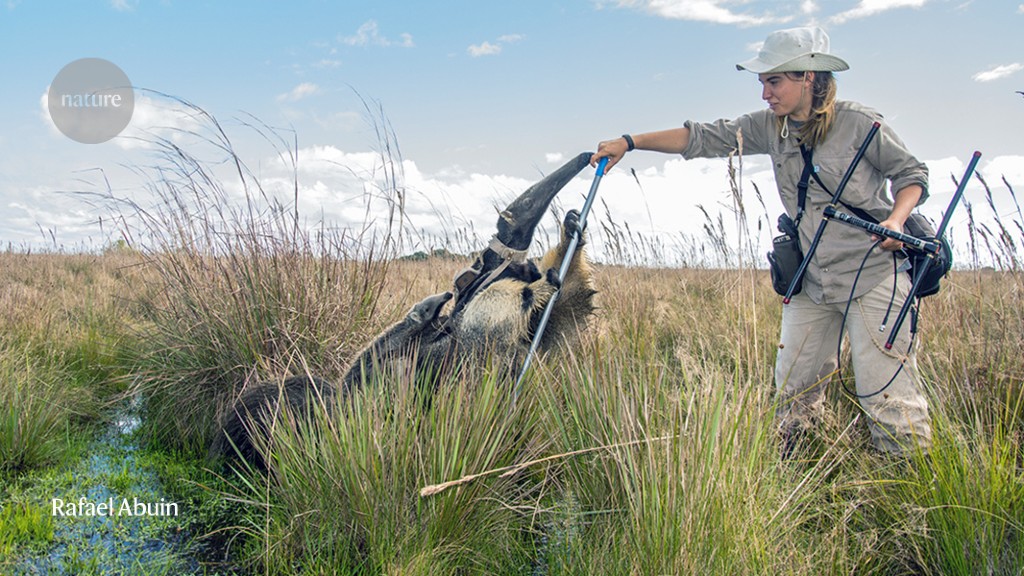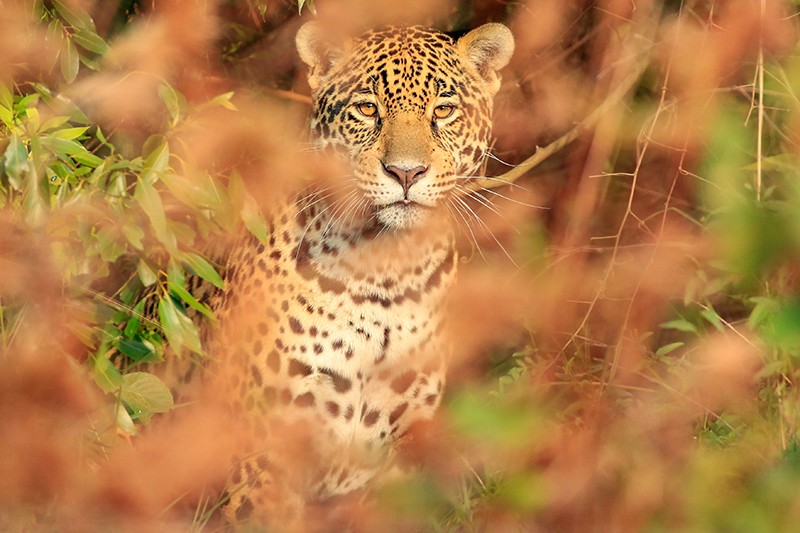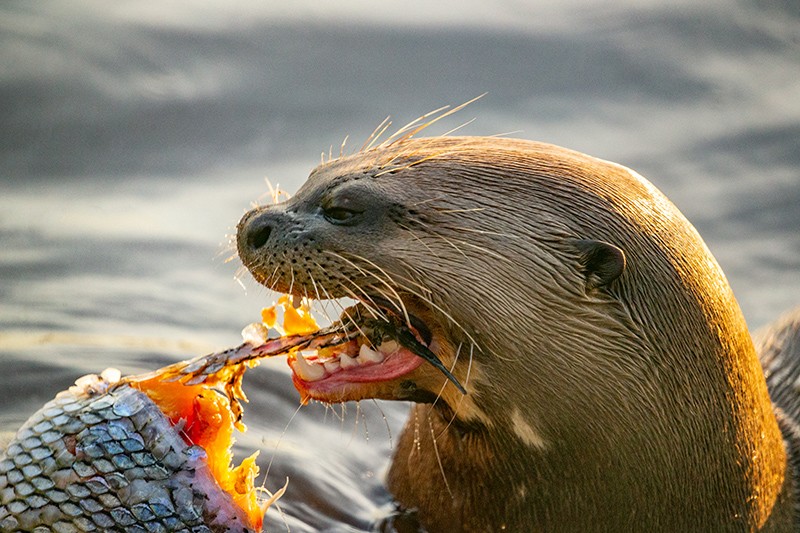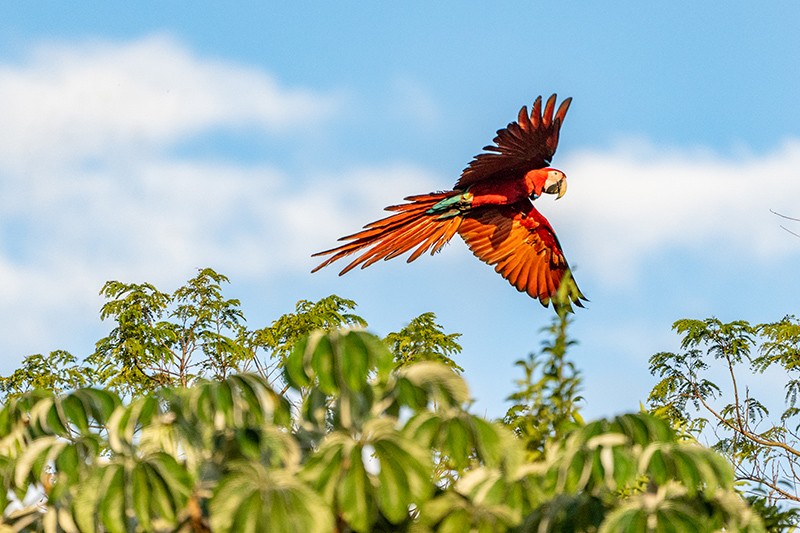When Mariuá, a 1.5-year-old female jaguar, set foot in our breeding centre in Argentina in December 2018, we did not know that she would make history. Two years later, she walked out with two cubs: the first jaguars to roam the 1.4 million hectares of the Iberá wetlands of northeastern Argentina for at least 70 years. Mariuá and her cubs have started to reverse a process that some had thought irreversible.
Within decades, one million species out of a total of some eight million could go extinct globally1. Hunting, habitat loss and ecosystem degradation are propelling this unprecedented biodiversity crisis. Current extinction rates are 100 to 1,000 times higher than in the past several million years.
Argentina is no exception. Over the past 150 years, 5 bird and 4 mammal species have gone extinct. Today, about 17% of the country’s 3,000 vertebrate species are imperilled2, and 13 out of the 18 extant species of large mammal, from anteaters to tapirs, are experiencing catastrophic declines, in terms of both number and geographical range (see http://cma.sarem.org.ar).
In 1998, we started a rewilding programme in Argentina to try to reverse this appalling loss. Our non-profit foundation, Fundación Rewilding Argentina, was spun out from the US non-profit organization Tompkins Conservation. We create protected areas where we can reintroduce native species, re-establish their interactions, restore ecosystem functionality and build valuable ecotourism based on wildlife viewing.
Both rewilding and ecotourism can be controversial. We think that our work is an instructive example of how active restoration of crucial species, when done responsibly, can benefit both ecosystems and local people. It should be in the toolkit for meeting the 2030 biodiversity targets that will be discussed at the Convention on Biological Diversity’s Conference of the Parties in Kunming, China, next month.
Three steps
The popularity of rewilding projects is growing. These include: wolves brought back to Yellowstone National Park in Wyoming, beavers to England, bison and musk ox to northern Russia, leopards to Mozambique and Tasmanian devils to mainland Australia. The International Union for Conservation of Nature reports that, since 2008, at least 418 reintroduction projects have been started3. Most of these projects occur in protected areas and involve one or a few species. Our work in Argentina is broader.
As a first step, we acquire private lands with philanthropic funds, reintroduce many species and form government-protected areas that are donated to federal and provincial governments. So far, we have purchased and donated about 400,000 hectares, with an estimated market value of US$91 million. This has created and enlarged six national parks, one national reserve and two provincial parks. Another 100,000 hectares are being donated. Together, these lands comprise a little over 10% of the total terrestrial area currently managed by the National Parks Administration of Argentina.
The second step is to restore ecosystems, mainly by reintroducing species at an unprecedented scale. We spend more than $3 million each year on rewilding activities in three regions: the Iberá wetlands in the northeast, the dry Chaco forests in the north and the Patagonian steppe and coast in the south. Most often, we work with species deemed to have large impacts at the ecosystem level, such as large predators and herbivores.
Thus far, we have successfully reintroduced pampas deer, giant anteaters and collared peccaries (a pig-like, hoofed animal). We have also started founding populations of jaguars, coypus (large aquatic rodents), Wolffsohn’s viscachas (rodents that resemble a large chinchilla), red-and-green macaws and bare-faced curassows (birds related to chickens and pheasants). We are currently working on the reintroduction of 14 species.
As they become abundant, reintroduced species re-weave the fabric of ecological relationships. For example, jaguars (Panthera onca) and macaws (Ara chloropterus) are reviving a crucial interaction: predation. Jaguars have begun to prey on eight species, including native rodents and feral hogs, which could limit those populations and thus benefit vegetation growth. The macaws are consuming 49 plant species, which could enhance seed dispersal, although this remains to be tested.
Third, we invest heavily in infrastructure, capacity building and publicity to create an economy based on ecotourism. The species we work with are often highly charismatic, which benefits local communities, creating an economic incentive to conserve native wildlife and habitats. We organize workshops and courses so that locals can train as nature guides, cooks, craftspeople and more. In Iberá, where our work is most advanced, tourist visits increased by 87% between 2015 and 2021, according to official data from the Iberá wetland management agency. There were more than 50,000 visitors last year, despite the COVID-19 pandemic.
All of these steps are important: simply setting aside protected areas is not enough. Globally, most modern ecosystems are ecologically damaged4, even in long-standing protected areas5. In Argentina, for example, functional populations of jaguars are missing from 19 of 22 national parks where historical distribution data suggest this key apex predator should occur.
Jaguars and capybaras
Our flagship project is the rewilding of the Iberá wetland. There, we are working on the restoration of nine species, including jaguars, which were eradicated from this area more than 70 years ago. We have now established a founding population of eight individuals: one adult male and three adult females, two of which (including Mariuá) were each released with two cubs aged four months. Our goal is to release a total of 20 individuals by 2027.
Of all the species we work with, giant otters (Pteronura brasiliensis) and macaws have been the most difficult. Both species are extinct in the wild in Argentina. Bureaucratic hurdles have made sourcing wild individuals from neighbouring countries impossible.
We obtained two pairs of giant otters from European zoos, and are holding them in pens in the core of Iberá. After several attempts, one pair bred successfully and the female gave birth to three cubs, producing the first litter born in the country for more than 30 years. We plan to release this family to the wild next year.
We source macaws, which have been extinct in the wild in Argentina for 100 years, from zoos, wildlife shelters and breeding centres. Because of their captive origin, we must give them the opportunity to practise flying in an aviary. We provide them with native foods, so that they learn what to eat, and we use a remote-controlled stuffed fox to teach them to avoid predators. This training isn’t always successful. Out of the 87 macaws that we have worked with, 48 were healthy and skilled enough to release. Two founding populations now thrive in the wild; one of them began reproducing in 2020.
Efforts elsewhere have demonstrated the powerful effects of restoring species. In the northeast Pacific Ocean, reintroduced sea otters (Enhydra lutris) have voraciously eaten sea urchins, which in turn has allowed the return of lush kelp forests6. In Yellowstone Park, some researchers argue that reintroduced wolves have discouraged herbivores from foraging along stream edges, which might have increased tree growth and stabilized stream banks7. In Mozambique’s Gorongosa Park, the return of wildebeest and other large herbivores has curtailed Mimosa pigra, an undesirable invasive shrub8.
Our rewilding work in Argentina could also have profound impacts. Close monitoring of the female jaguars and their cubs in the Iberá wetland has shown that they are largely feeding on the most abundant native prey: capybaras (Hydrochoerus hydrochaeris). Reducing the number of capybaras is expected to allow more vegetation to thrive, providing habitat for arthropods and small vertebrates, and possibly increasing carbon sequestration9. It could also help to reduce the transmission of sarcoptic mange, a density-dependent disease plaguing the capybara population. Jaguars also prey on foxes, which might benefit threatened bird species. We are working with several academic institutions to test how the return of the jaguar is reshaping the ecosystem.
Challenges and caveats
As our rewilding work gained momentum, critics ramped up from different fronts. At first, some were fearful of our policy of acquiring private lands with funds provided largely by foreign philanthropists. Those concerns faded when we began donating the land to federal and provincial governments.
Then, ranchers argued that we were taking agricultural land out of production and reintroducing or boosting populations of animals that would conflict with their livestock. For example, in Patagonia, we established several protected areas where pumas (Puma concolor) and guanacos (Lama guanicoe, a relative of the llama) thrive. For almost a century, ranchers have trapped, shot and poisoned these animals, blaming them for killing sheep and competing for forage, respectively. We are conducting research to quantify the impact of pumas and guanacos on livestock, and offering alternative job opportunities based on wildlife viewing.
Federal and state managers, and often academics, argue that some founding populations of reintroduced species are too small and genetically related to create a viable, long-term population. This is true in some cases. But careful releases of unrelated animals can sidestep this issue. Worries about the spread of diseases when translocating individuals is also often invoked as a reason to halt rewilding activities. We implement thorough health checks and rigorous quarantines to decrease the risk of introducing unwanted diseases in the regions where we work.
Concerns are sometimes raised about whether reintroduced species will recreate historical conditions, or instead create something new. Rewilding, however, seeks to regenerate and maintain ecological processes and biodiversity, rather than reaching some specific, historical equilibrium10. We think it is preferable to assume the uncertainties in trying to restore ecosystems, rather than accepting their degraded state.
Another worry is the possible impacts that tourism can have on climate, biodiversity and society — for instance, on water use, aviation emissions, road building and so on. Our strategy is to limit visitor numbers and avoid crowding by constructing multiple access gates on existing dirt roads.
There are many policies that hinder rather than help rewilding. In Argentina, the laws that regulate transportation of wildlife species are built on the assumption that such activities always represent a threat to conservation. Wild animals can typically be imported to the country only through an airport in Buenos Aires. Because of this, an animal that could be driven in a truck from Brazil in a few hours must instead fly more than 1,500 kilometres and then be driven all the way back to its release area. Receiving wild animals at another international port, or moving them around within the country, requires special permits that often take months to obtain. Regulations could be altered to ease rewilding efforts while still policing the illegal wildlife trade.
Next steps
Nature-based tourism has been growing globally at rates of more than 4% per year, particularly in low- and middle-income countries11. Charismatic fauna, including large predators, are becoming increasingly important. In the Brazilian Pantanal, the world’s largest wetland, wildlife viewing — mostly of jaguars — generated an annual revenue of $6.8 million in 2015. This is three times the revenue obtained from traditional cattle ranching in that region12.
With about 97% of the planet’s land surface ravaged by humans4, nature is facing its last stand. Urgent measures are needed not only to halt but also to reverse ecosystem and biodiversity loss. The active reintroduction of key species is one powerful way to heal some degraded ecosystems.
This daunting task should not fall solely to non-profit organizations that have limited funds and staff, like us. The United Nations launched its Decade on Ecosystem Restoration in June 2021, calling for massive restoration efforts worldwide to heal nature and the climate. To achieve meaningful results at a global scale, rewilding needs the support of many stakeholders and effective international cooperation. Crucially, it requires the active involvement of governments to facilitate, fund and lead restoration efforts.










More News
Could bird flu in cows lead to a human outbreak? Slow response worries scientists
US halts funding to controversial virus-hunting group: what researchers think
How high-fat diets feed breast cancer